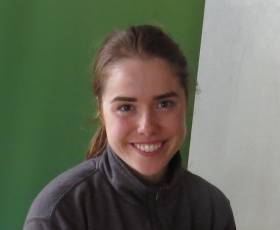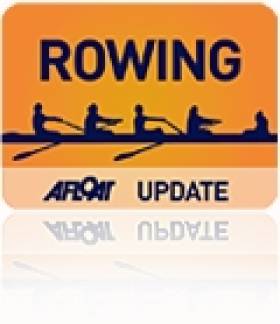Displaying items by tag: Katie O'Brien
Katie O'Brien Crowned 2022 PR2 W1x World Rowing Champion
Katie O'Brien is the 2022 PR2 W1x World Rowing Champion! The first day of the finals in the Czech Republic has got off to a good start, with a gold medal in Ireland's pocket already.
O'Brien showed fierce strength from her very first stroke, nudging her bow ahead of the other scullers. She was the fastest moving boat throughout the race, increasing her lead with each quarter. Up against the previous World Champion, Katherine Ross from Australia, Katie knew that it would be no easy feat. Katie finished in a time of 9:25.23, ten seconds ahead of Australia in second place.
 Katie O'Brien (centre) wears the gold medal after and defeating PR2 W1x defending champion Katherine Ross from Australia
Katie O'Brien (centre) wears the gold medal after and defeating PR2 W1x defending champion Katherine Ross from Australia
This is the first time that Katie has beaten Ross.
It's straight back into focus now for Katie as she heads into the PR2 Mixed Double A Final tomorrow afternoon with Steven McGowan.
Zoe Hyde (Killorglin RC) and Sanita Puspure (Old Collegians) returned to the water today for the A/B Semi of the Women's Double. After a quick start, the double form Ireland were the first to reach the 500m mark, staying bow ball to bow ball with Laila Youssifou and Roos de Jong of the Netherlands, right up to the halfway point. The Dutch crew began to pull away creating a length's lead on Ireland, but Zoe and Sanita stepped it up another gear in the final quarter of the race, to finish less than a second and a half behind them. They race again this Sunday in their A Final.
Lydia Heaphy (Skibbereen RC) finished in third place in the Lightweight Women's Scull B Final, ranking her ninth in the world. Crossing the first marker in fifth place, Lydia pushed on through the race finding speed and moving through the rowers from Spain and the USA to take that third position.
Hugh Moore finished up his World Championships with a third place in the D Final of the Lightweight Men's Scull. Similar to Lydia's race, Hugh started behind and gradually came through his competitors, to take third position. Off the start, the Finnish and Tunisian scullers were ahead but by the 1500m mark, Moore had moved ahead. He finished behind Lukasz Sawicki from Poland and Oscar Peterson from Denmark.
Ireland Results
PR2 W1x A Final - Gold
W2x A/B Semi 2nd -> A Final
LW1x B Final - 3rd
LM1x D Final - 3rd
Saturday Schedule (IST)
10:48am - W2- B Final
11:28am - M4- B Final
12:05pm - PR2 Mix2x A Final
1:07pm - LW2x A Final
1:23pm - LM2x A Final
1:39pm - W4- A Final
Fine Start at World Championships by Katie O'Brien
#Rowing: Katie O'Brien took a fine third place in her first race of the World Rowing Championships. The Galway woman's contest came in a preliminary round - but it was a notable contest, as Kathryn Ross of Australia won in a new world's best time of nine minutes 24.99. Behind her Annika van Der Meer of Netherlands fought it out with O'Brien, who finished well to the cheers of the Irish crowd in the grandstand.
World Rowing Championships, Day Four (Irish interest)
Women's PR Two Single Sculls, Preliminary Race: 1 Australia (K Ross) 9:24.99; 3 Ireland (K O'Brien) 9:52.13.
Para Rower O'Brien Gives Ireland a Women's Henley Win
#ROWING: Katie O’Brien from Galway won on her debut at Women’s Henley today. The 17-year-old pararower from the Tribesmen club won the Arms and Shoulders single scull, beating Claire Connon from Cantabrigian by three lengths.
O’Brien represented Ireland in the 2013 World Cup at Dorney Lake, partnering Keith Connolly in the Trunk and Arms mixed double scull.
The young pararower has said her long-term ambition is to compete at the 2016 Paralympic Games in Rio, in the Trunk and Arms discipline, where the only event is a mixed double scull.
Women’s Henley (Finals; Irish interest):
Trunk and Arms Single Sculls: Tribesmen (K O’Brien) bt Cantabrigian (C Connon) 3l, 4 minutes 39 seconds.

























































